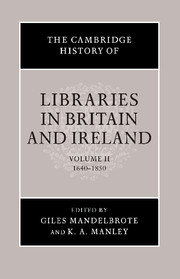Book contents
- Frontmatter
- 1 Introduction: the changing world of libraries – from cloister to hearth
- PART ONE THE EXPANSION OF BOOK COLLECTIONS 1640–1750
- PART TWO LIBRARY DEVELOPMENT AT A LOCAL LEVEL
- PART THREE PROVINCIAL AND METROPOLITAN LIBRARIES 1750–1850
- 18 Libraries in context: social, cultural and intellectual background
- 19 The book trade and libraries
- 20 Ecclesiastical libraries
- 21 Libraries in the parish
- 22 Books and universities
- 23 Libraries and literacy in popular education
- 24 Scientific and medical libraries: the rise of the institution
- 25 The first century of the British Museum library
- 26 The impact of the British Museum library
- 27 Private libraries in the age of bibliomania
- 28 Library architecture and interiors
- 29 Library management in the pre-professional age
- 30 Libraries for an imperial power
- 31 Engines of literature: libraries in an era of expansion and transition
- Select bibliography
- Index
- References
28 - Library architecture and interiors
from PART THREE - PROVINCIAL AND METROPOLITAN LIBRARIES 1750–1850
Published online by Cambridge University Press: 28 March 2008
- Frontmatter
- 1 Introduction: the changing world of libraries – from cloister to hearth
- PART ONE THE EXPANSION OF BOOK COLLECTIONS 1640–1750
- PART TWO LIBRARY DEVELOPMENT AT A LOCAL LEVEL
- PART THREE PROVINCIAL AND METROPOLITAN LIBRARIES 1750–1850
- 18 Libraries in context: social, cultural and intellectual background
- 19 The book trade and libraries
- 20 Ecclesiastical libraries
- 21 Libraries in the parish
- 22 Books and universities
- 23 Libraries and literacy in popular education
- 24 Scientific and medical libraries: the rise of the institution
- 25 The first century of the British Museum library
- 26 The impact of the British Museum library
- 27 Private libraries in the age of bibliomania
- 28 Library architecture and interiors
- 29 Library management in the pre-professional age
- 30 Libraries for an imperial power
- 31 Engines of literature: libraries in an era of expansion and transition
- Select bibliography
- Index
- References
Summary
Architecturally, the two principal classes of library, in the later eighteenth century, are the great house, and the institution. Subscription libraries were quite small, usually in private houses or bookshops, though in major cities a few were purpose-built. Very few commercial libraries compared with James Lackington’s, who claimed his catalogue offered 30,000 volumes in 1784 – when, in his view, the trend began that multiplied the sale of books fourfold in 20 years.
During the ensuing century a shift from representational architecture to utilitarian architecture was slow to emerge, as is indicated by A. L. Humphreys’s remark that ‘the architect is very frequently a great enemy to the library’, providing too little wall space for books or placing them inaccessibly. Masson notes that constructors sought to increase light by enlarging windows, to the loss of wall surfaces; an effect enhanced by substituting first ivory and then white surfaces for the traditional natural wood panelling. The standard eighteenth-century library was the traditional wall library in which books were shelved against perimeter walls, described as a matter of course in J. F. Blondel’s Cours d’architecture (vol. 2, 393) of 1771, and sustained in J.-N.-L. Durand’s influential Recueil et parallèle of 1801 and his Précis des leçons (1802–5). Major library buildings in the British Isles during this period generally retained that form, although the stall system employed by Wren at Trinity College, Cambridge, in 1676, also proved an important model. Pevsner sees the most important development of the period as separating books from readers by creating books-tacks away from reading rooms, found first at Karlsruhe in 1761 (or 1765), but only established by its advocacy in Leopoldo della Santa’s Della construzione e del regolamento di una publica universale biblioteca, con la pianta dimostrativa (Florence, 1816), described by Denis Keeling as an endeavour ‘to plan a library from an entirely utilitarian point of view’, important for ‘its provision of separate areas designated for readers, staff and book storage, and for the generous accommodation provided for the latter’.
- Type
- Chapter
- Information
- The Cambridge History of Libraries in Britain and Ireland , pp. 459 - 478Publisher: Cambridge University PressPrint publication year: 2006



